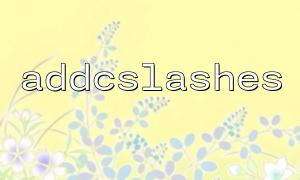In PHP programming, you often encounter situations where strings need to be escaped, especially when working with database interactions, regular expressions, or outputting HTML content. Escape characters help us prevent certain special characters from being misinterpreted or executed. In most cases, the addslashes() function effectively escapes strings, but in some specific scenarios, we may want to preserve original characters while avoiding double escaping. In such cases, the addcslashes() function provides a more flexible solution.
In PHP, the addcslashes() function is used to escape specified characters within a string. Unlike addslashes(), addcslashes() allows developers to define which characters should be escaped, giving us greater control.
<span><span><span class="hljs-keyword">string</span></span><span> </span><span><span class="hljs-title function_ invoke__">addcslashes</span></span><span>(</span><span><span class="hljs-keyword">string</span></span><span> </span><span><span class="hljs-variable">$str</span></span><span>, </span><span><span class="hljs-keyword">string</span></span><span> </span><span><span class="hljs-variable">$charlist</span></span><span>)
</span></span>$str: The string to be processed.
$charlist: The set of characters to escape. This can be a single character, multiple characters, or even a character range (for example: a-z).
addcslashes() escapes characters in $str that match those defined in $charlist. Unlike addslashes(), addcslashes() does not automatically escape single quotes (') or double quotes ("); instead, it only escapes what you specify in $charlist.
Suppose you have a string that already contains several escape characters, and you want to escape them without re-processing the ones that are already escaped. Using addcslashes() helps avoid double escaping while keeping the original characters intact.
<span><span><span class="hljs-variable">$str</span></span><span> = </span><span><span class="hljs-string">"This is a 'test' string with special characters like \n, \r, and \t."</span></span><span>;
<p></span>$escapedStr = addcslashes($str, "\n\r\t");<br>
echo $escapedStr;<br>
</span>Output:
<span><span>This </span><span><span class="hljs-keyword">is</span></span><span> a </span><span><span class="hljs-string">'test'</span></span><span> </span><span><span class="hljs-built_in">string</span></span><span> </span><span><span class="hljs-keyword">with</span></span><span> special characters like \n, \r, </span><span><span class="hljs-keyword">and</span></span> \t.
</span></span>In this example, only \n, \r, and \t are escaped. In contrast, addslashes() would escape more characters. If the string already contains these escape sequences, addcslashes() ensures they aren’t processed again.
Sometimes, you may want to escape only a specific range of characters, such as all lowercase letters or numbers. With the flexibility of addcslashes(), this is easy to achieve.
<span><span><span class="hljs-variable">$str</span></span><span> = </span><span><span class="hljs-string">"This is a test string 1234!"</span></span><span>;
</span><span><span class="hljs-variable">$escapedStr</span></span><span> = </span><span><span class="hljs-title function_ invoke__">addcslashes</span></span><span>(</span><span><span class="hljs-variable">$str</span></span><span>, </span><span><span class="hljs-string">'a-z'</span></span><span>); </span><span><span class="hljs-comment">// Escape all lowercase letters</span></span><span>
</span><span><span class="hljs-keyword">echo</span></span><span> </span><span><span class="hljs-variable">$escapedStr</span></span><span>;
</span></span>Output:
<span><span>This </span><span><span class="hljs-keyword">is</span></span><span> \a \t\es\ t </span><span><span class="hljs-built_in">string</span></span><span> </span><span><span class="hljs-number">1234</span></span><span>!
</span></span>In this case, only lowercase letters a-z are escaped. You can adjust the character set as needed for more customized escaping.
When building regular expressions, you often need to handle special characters safely. addcslashes() is a very useful tool for this, as it allows you to escape characters that could otherwise interfere, such as a period (.) or asterisk (*).
<span><span><span class="hljs-variable">$pattern</span></span><span> = </span><span><span class="hljs-string">"This is a test with some special characters like . * + ?"</span></span><span>;
</span><span><span class="hljs-variable">$escapedPattern</span></span><span> = </span><span><span class="hljs-title function_ invoke__">addcslashes</span></span><span>(</span><span><span class="hljs-variable">$pattern</span></span><span>, </span><span><span class="hljs-string">'.|*+?()[]{}^$\\'</span></span><span>);
</span><span><span class="hljs-keyword">echo</span></span><span> </span><span><span class="hljs-variable">$escapedPattern</span></span><span>;
</span></span>Output:
<span><span>This </span><span><span class="hljs-keyword">is</span></span><span> a test </span><span><span class="hljs-keyword">with</span></span><span> </span><span><span class="hljs-keyword">some</span></span><span> special characters </span><span><span class="hljs-keyword">like</span></span><span> \. \* \+ \?
</span></span>This way, when building regular expressions, you can ensure special characters won’t cause errors or unintended matches.
When handling SQL queries, preventing SQL injection is critical. While using PDO or MySQLi prepared statements is the recommended approach, there may be cases where you still need to escape user input to reduce risks. addcslashes() can help escape special characters in user input, improving SQL query safety.
<span><span><span class="hljs-variable">$userInput</span></span><span> = </span><span><span class="hljs-string">"Robert'); DROP TABLE Students;--"</span></span><span>;
</span><span><span class="hljs-variable">$escapedInput</span></span><span> = </span><span><span class="hljs-title function_ invoke__">addcslashes</span></span><span>(</span><span><span class="hljs-variable">$userInput</span></span><span>, </span><span><span class="hljs-string">"'"</span></span><span>);
</span><span><span class="hljs-keyword">echo</span></span><span> </span><span><span class="hljs-variable">$escapedInput</span></span><span>;
</span></span>Output:
<span><span>Robert\'); DROP TABLE Students;--
</span></span>By escaping single quotes, you can prevent SQL injection attempts. While this is not as secure as using prepared statements, it still provides some level of protection.
addcslashes() is a powerful PHP function that offers a flexible way to escape specific characters in a string. Unlike addslashes(), addcslashes() lets you define exactly which characters to escape, giving you finer control over the process. Whether it’s avoiding double escaping, handling regular expressions, or mitigating SQL injection risks, addcslashes() can play an important role.
Understanding and properly applying this function can help improve both the efficiency and security of string handling in your PHP projects.
Related Tags:
addcslashes



